jpg” border=”0″ hspace=”5″ align=”right” alt=””/>
The Lucas Off Road Racing Series (LOORRS) is an evolution of the long-standing support of short course racing by Forrest Lucas and Lucas Oil. Steeped in the Midwest tradition of short course off-road racing, infused with a West Coast influence, LOORRS brings intense four-wheel, door-to-door action to challenging, fan-friendly tracks. (http://lucasoiloffroad.com)
And still yet another type of off-road racing that incorporates a lot of mud racing is SCORR: Short Course Off Road Racing. (www.scorrtrucks.com)
Admittedly, there have been downs as well as ups for some of the bigger off-road events over the years. The now defunct Mickey Thompson Stadium Series was popular for a time, but many feel it was simply ahead of its time. The series, which ran from the early 1980s until it went bankrupt in 1996, was set up as a dirt course inside various stadiums to give fans an opportunity to view the race in a smaller setting.
And then there was Championship Off Road Racing (CORR), an off-road racing short course sanctioning body that formed 1998, only to go into bankruptcy last year.
But for the most part, the interest in off-roading continues to rise in many states across the U.S. And, every magazine stand at national bookstores features various types of off-road or four-wheeling enthusiast periodicals.
Engine Differences
So how does this benefit you, a future engine builder? Plenty, especially if you seek a position with either a race team or a shop that caters to the off-road niche market where endurance engines are king.
You see, in various Trophy Truck classes, which feature a pickup truck with a fiberglass body, the only rules are primarily for safety. Everything else – from the engine to the suspension – is unrestricted. 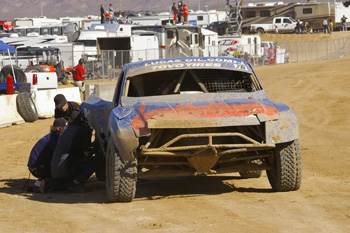
“There are many big cubic-inch, fully sequential electronic fuel-injected small blocks running in the Trophy Truck class,” said Kevin Kroyer of Kroyer Racing, Las Vegas, N. Kroyer builds engines for some of the top teams in Trophy Truck and Super Buggy. (www.kroyerracingengines.com)
“There’s no size limitation; you can run whatever size engine you want. Most of the trucks are front engine, but there are a few mid-engine trucks as well,” he said.
They look like pickup trucks, but that’s where the similarities end, said Kroyer. “In NASCAR Craftsman Truck Series racing (for which Kroyer has also built engines), there’s at least some sheet metal that is the same as the production truck. This is not the case in Trophy Trucks, which aren’t held to any templates. These are tubular-framed race vehicles that cost about $500,000 even before you put a powertrain in them.”
Most of the differences in building engines for off road SCORE or desert endurance racing purposes, say experts, concern the endurance factor. The annual Baja 1000 is actually 1,300 miles of punishing off-road racing. The winner will take 25 or 26 hours to complete the race, so the engines have to last for that long. 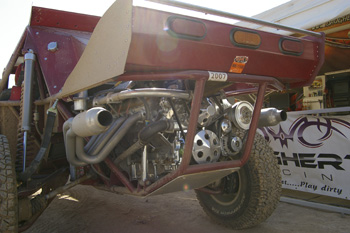
They are pushing 6,500 lbs., in the case of a Trophy Truck, over all conditions and unlimited terrain for that entire span of time and distance.
“The trucks will average somewhere around 55 mph for the race,” says Kroyer. “In some of the dry lakebeds, the trucks can get up to 140 mph, but then there are sand washes and rock gardens where they might not even do 20 mph. We build engines to have a very broad torque band because you’re pushing such a heavy vehicle.”
Kroyer and others say the off road market has been growing steadily over the last couple of years. “We’ve been doing off road engines for a long time,” says Kroyer, “but the market has picked up for us, especially in the SCORE Series and Trophy Truck classes, as well as the Buggy classes.
"The endurance races seem to be growing and our customer base has picked up quite a bit. SCORE has had record entries in Trophy Truck and Class 1, which is Unlimited Buggy class. They have had record entries for just about every race this year.”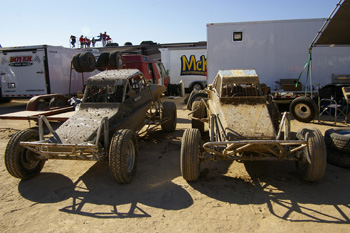
Going Small
Another engine builder who has had success with off-road engines is Rick Caven of Speed-O-Motive, West Covina, CA. (www.speedomotive.com)
Caven, who grew up road racing and still loves that form of racing, said the short-track off road venues are very exciting as well. “Spectators can see all the way around the track, and you really can get close access the racers and teams. It’s not the same thing as desert racing because guys are really racing against each other here. Desert racing is more wide open.”
Speed-O-Motive did some development work for short course racers — the Baldwin Team years earlier. After which, the team stepped up and had Caven design a completely new engine.
“Our engine is a 390 cubic-inch small block. It’s solely designed for this form of racing, although we used influences for the design from other forms of racing,” said Caven. 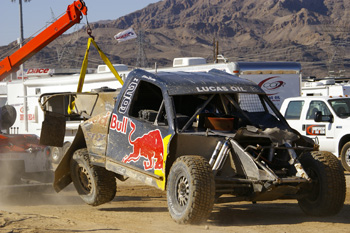
“We picked some of the best characteristics of engines to put into this one, but, basically, we started with a completely clean sheet of paper. We designed and built our own billet blocks, and it seems to be working really well so far.”
Craven explained there are differences in the engines for desert off-road and short tracks. “A desert motor has a little less compression because we try to make them live longer. The desert motors make a little less power, but it’s a trade off between power and longevity. It’s not very often that a desert motor will see 7,000 to 8,000 rpm, but in the short course series you see 9,700 rpm and some of the bigger cubic inch motors are turning just under 8,000 rpm.”
He and other off-road experts say some of the bigger cubic inch engines can actually make too much torque for the off-road racing. “Unless you get a driver who can really control his right foot, those bigger engines will just spin the tires, not putting the power down to the ground,” says Caven. “This is especially the case in two-wheel drive truck events.”
Those difficulties with the big cubic inch engines are why Caven started building the small block fuel-injected engine in the first place. It allows him to control the mapping completely. 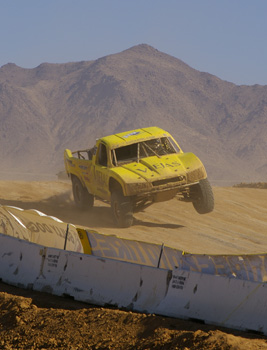
“We bring the torque in a lot with the smaller engine with about 600 lb.ft of torque. We bring it in slow and it lasts a long time. One of our drivers has told us that the engine never stops pulling. With too much torque it just rattles the tires and you just sit there.”
Looking Down the Horizon
Caven acknowledges that the bar keeps moving up every year and challenges engine builders to step up to the new technology and learn how to make the most of it. Otherwise, he says, you are not going to have much success.
Experts say that includes stepping up your game in the machining process and metal treating processes as well as component selection. You can’t just buy an aftermarket block off the shelf and expect to win anymore. There are a number of processes you have to do to the blocks for the engines to be competitive and to last.
For example, cryogenic processing has been around for number of years in NASCAR, but it is starting to be used in off-road racing, as well as many other forms of racing.
The only areas where he sees problems with dirt are around the velocity stacks and the airbox. And, because they are pulling so much vacuum in the engine, they have to run special seals. “I lost an engine a couple of years ago in the desert because one of our seals failed, which was a standard heavy-duty seal, but it sucked in a lot of dirt. It didn’t blow up but it didn’t look good either. So now we use a special seal. If we didn’t run as much vacuum, we could probably run the stock seals,” says Caven.
“I don’t think any one team or builder has all the answers in this series,” says Caven. “The rules say you can run one carburetor, one throttle body EFI, or you can run multiple stack-style fuel injection, which is what we run. From my Sprint Car days, I’ve come to understand it a little better. The engines have a different characteristic with this setup. I think it’s a very good setup for this class.
"We can treat each cylinder as an individual engine with the multiple stack system, which is something you can’t do with a carb or throttle body EFI. We can break things up a bit more and run a different fuel and timing map per gear. Right now, there are only two gears, but with the smaller engines there are multiple gears," Caven said.
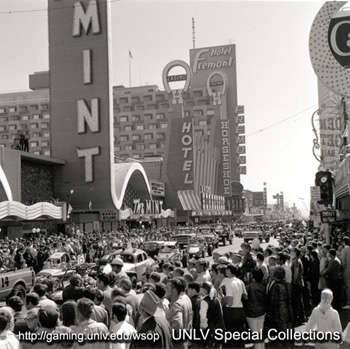 Vegas Venues
Vegas Venues
The Mint 400 used to be one of the most prestigious off-road events in the country, and it was held just outside of Las Vegas. The organizers would close Fremont Street and turn it into a large garage for tech inspections. After a 20-year hiatus, the Mint 400 was revived in 2008. This year, more than 250 teams competed in the race which has been moved to an area near the Moapa Indian Reservation in Nevada.
Upcoming engine builders may find lighter, smaller engines are the future because they allow for better handling, say experts. Most of the engines are mounted in the front, but there are no rules saying where the engine has to be mounted. It’s up to the teams to decide what works best. And, there aren’t many rules for the engines, which has got to be music to an engine builder’s ears.


